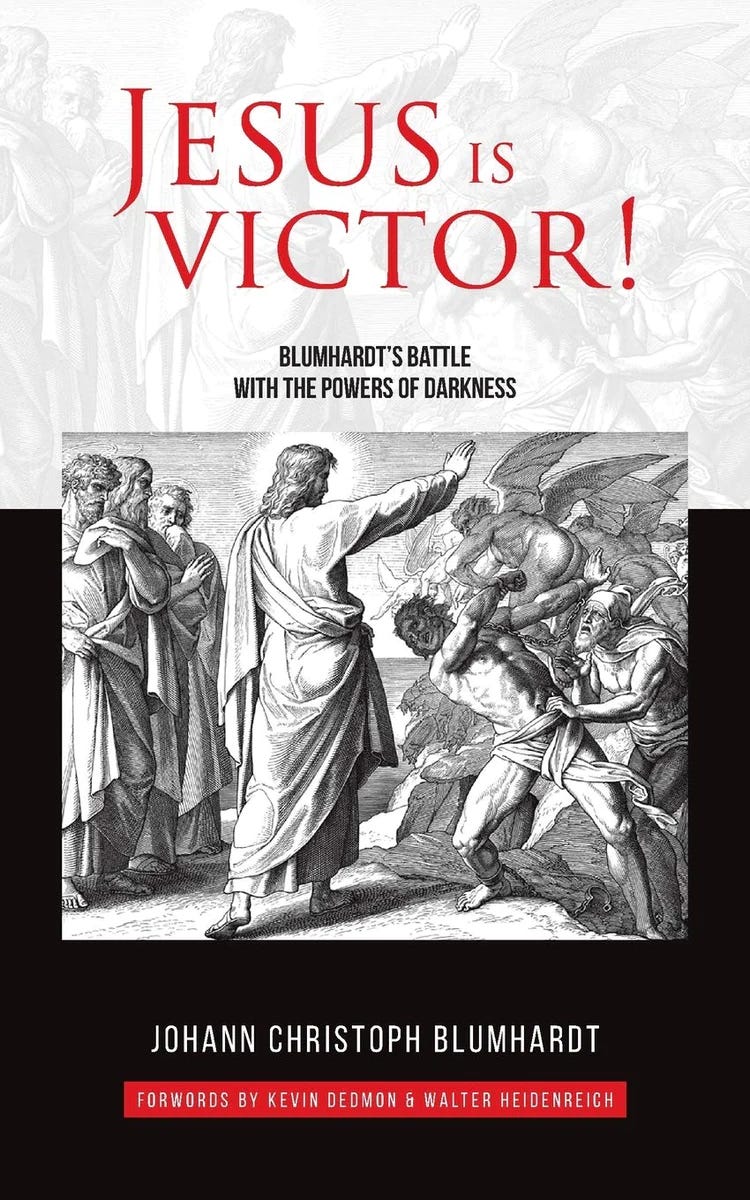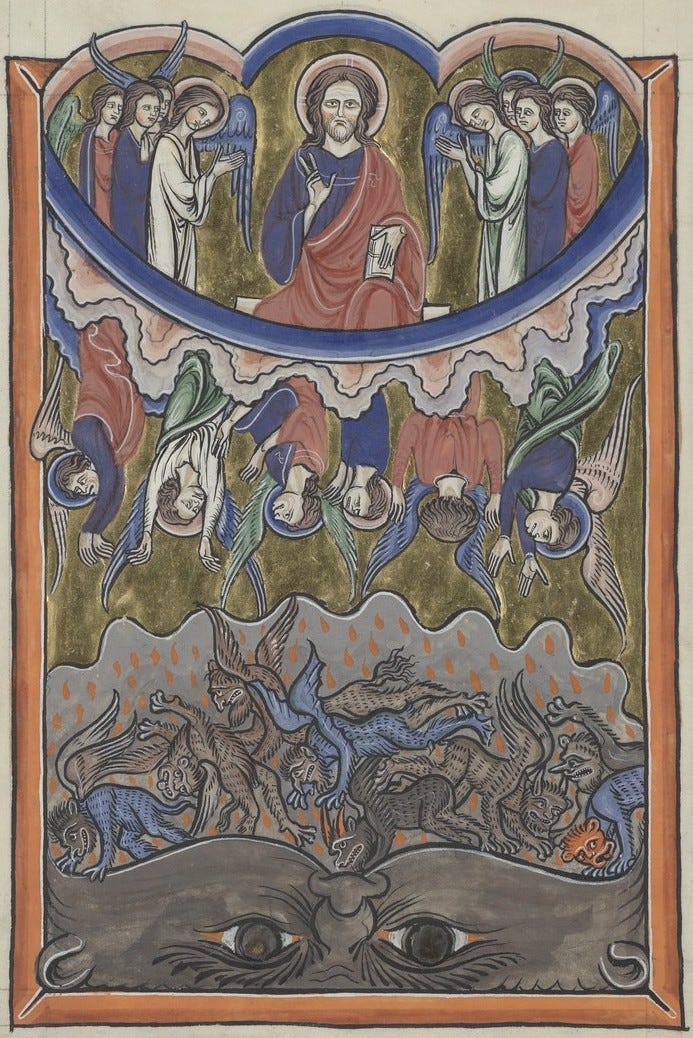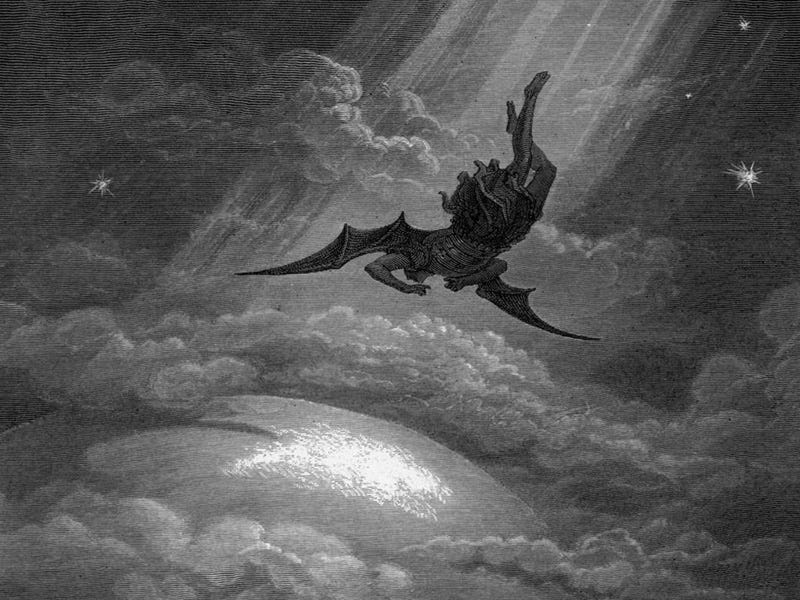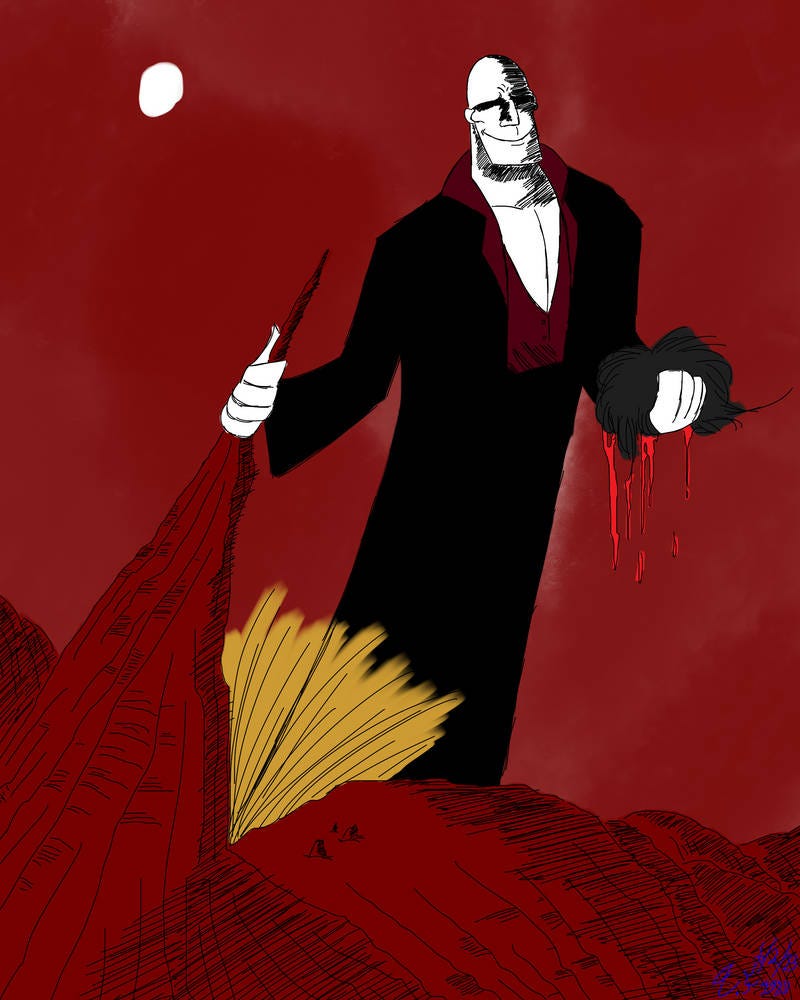Revelation 9.1-6, 20-21
Writing in the Bulwark in April, columnist Cathy Young reflected upon the one year anniversary of the atrocities the Russian army committed in the quiet suburban town of Bucha.
As Russian forces fled Bucha in hasty retreat, journalists who entered the liberated town encountered the bodies not of soldiers but civilians, “…in charred remnants of cars, in the front yards of homes, in parking lots, in basements—and in mass graves.”Vladimir Putin, his propagandists in the Kremlin and on rightwing platforms, and even the patriarch of the Russian Orthodox Church lied, declaring that “the dead bodies weren’t actually dead,” and accusing the victims of being crisis actors. Possibly, they averred, spinning another falsehood, the dead bodies had been murdered by Ukrainian Nazis after the noble Russian forces had departed Bucha. Along with eyewitness accounts, real-time security camera footage and satellite images attest to the atrocities, not simply murder but rape and torture.
In an anniversary interview, an advisor to Vladimir Zelensky explained how Bucha had been a revelation not only to Ukrainians but to the entire world:
“Bucha was the starting point that transformed our—and the world’s—emotional understanding of this war. That is, at that moment we realized that Russia did not come here to achieve . . . military aims. All those absurdities they talked about. Russia came here specifically, in the twenty-first century, to kill with extreme cruelty. Just look at what happened systemically in Bucha, in Hostomel. . . . Russia built, and came here with, a ready-made system for the extremely cruel murders on a large scale of Ukrainian citizens. And Bucha showed that [reality] for the first time, not only to us but showed it to the whole world.”
A Russian expatriate writer echoed the sentiment, explaining on social media, "It was clear that after Bucha, [this] wasn’t a war intended to make Ukraine do this or that. It was a war of destruction.”
This April, at a grave ceremony in Bucha, President Zelensky framed the horrors of Russia’s invasion in apocalyptic terms.
“When Bucha was de-occupied,” he said, “we saw that the devil was not somewhere out there but here on earth. The heinous truth [of the devil and his minions] was revealed to the world.”
The Ukrainian president is neither the first nor the only Ukrainian to speak in theological terms of the atrocities they’ve seen and suffered. The police chief of Kyiv was on the front line to liberate Bucha. When he entered the razed town, he came upon the bodies of the massacred. “We realized,” he said, “that, in fact, evil had dwelled on this land for a month…whose sole intent was to kill and abuse peaceful civilians.”
Evil had dwelled here, he said.
Evil as person.
Still more disquieting is the manner in which the devil and his demons manifested themselves. As Cathy Young notes, there is no evidence the war crimes committed in Bucha were the result of a deliberate Russian policy. Rather, by and large, Russian soldiers simply believed the propaganda told to them that the purpose of the invasion was to rid the land of Nazis who were terrorizing the captive populace of Ukraine. They took the lies as truth. And when they discovered the truth was a lie, when they realized the people of Bucha received them not with “jubilant gratitude” but with dread and loathing, the Russian soldiers did not repent. They reacted with “aggrieved rage.” Those they did not dump in mass graves, they left strewn in the street, shot, their hands tied behind their backs using the white civilian flags they had waved in fright.
The devil was not somewhere out there but here.
If there, then here.
And so, everywhere.
Unlike the previous furies, the fifth and sixth woes unleash an otherworldly specter, visible only to human imagination and corresponding to no earthly reality. When the fifth and six angels blast their trumpets, the Seer sees locust-like creatures and a calvary of horses with men’s faces and women’s hair. John sees a star fall from heaven to the abyss. From the abyss, thick smoke envelopes the whole creation such that the world is shrouded in deep and stubborn darkness. The abyss is whence the locusts and scorpions and quasi-human calvary come and, together, they inflict upon the earth an anguish worse than death.
Once again in the Book of Revelation, the creatures are extraordinary, their attributes are arresting, and the details overwhelm with their minutiae.
Nevertheless!
We commit a fatal mistake if we take the world so described by Revelation as any other but our own.
Remember, the Spirit of Jesus has caught John the Beloved Disciple up into heaven— yes— but the world the Seer is then given to see is our world as it appears from heaven’s vantage.
John sees our here as it looks from God’s there.
The fifth and sixth angels do not open up an otherworldly, supernatural realm. John depicts the world with a prophet’s pictures and riddles rather than with a reporter’s who, what, when, and where. The Apocalypse is prophetic not journalistic, but— make no mistake— the Book of Revelation is every bit as realistic as the Washington Post. For instance, the Old Testament prophet Joel speaks of the Day of the Lord— the harbinger of God in judgment and wrath— as the arrival of an invading army of locusts. Thus, that John shows you a world swarmed by a legion of locusts means that, from heaven, John sees the earth in league with what Karl Barth calls “the lordless powers.”
The prophet puts it plainly at the end of this passage. The lordless powers’s lies are so seductive that captivity to them extends across humankind who, unawares, worship demons and, unrepentant, wreak destruction. In other words, the devil is not somewhere out there; he is legion.
Notice the first verse.
John calls the star he.
He goes by many names.
Peter calls him Lucifer. Paul calls him the Enemy. Jesus calls him the Father of Lies. But here he first appears like falling lightening. And he is handed over the key to the abyss whence the demons come.
John sees what Paul says, “Therefore God handed them over in the lusts of their hearts to impurity, to the degrading of their bodies among themselves.”
John sees what Paul says, “For this reason God handed them over to degrading passions.”
John sees what Paul says, “And since they did not see fit to acknowledge God, God handed them over to a debased mind and to things that should not be done…they not only do them but even applaud others who practice them.”
God handed them over.
The Apocalypse reveals to whom we have been handed.
Quite simply, John sees that Satan and his demons have been given license to afflict the inhabitants of the earth. Thus John’s prophetic picture and Paul’s apostolic proclamation are the same.
The Spirit of Jesus shows John nothing more mysterious than our monstrous world.
Starting out as a rookie preacher, Karl Barth struggled with translating the ancient, premodern world of the Bible for contemporary listeners. As happens with many preachers, seminary had nearly wrung the faith out of Barth, rendering the Bible as a text to be demythologized rather than declared.
However, when Barth discovered that all of his former professors had fallen under the Kaiser’s spell and signed an enthusiastic endorsement of Germany’s unprovoked war, Barth concluded the liberal theology they had handed over to him was rotten at the core. He immediately set upon the task of rebuilding his faith from the ground up.
Around the same time, while Barth was attending his brother’s wedding, he and a friend traveled a short distance to the town of Bad Boll in order to meet Christoph Blumhardt, a young pastor whose father, Johann Blumhardt, had, some years earlier, exorcised a demon from a young woman in his parish. The exorcism had sparked a revival in southern Germany.
The young woman’s name was Gottlieben Dittus.
She lived with her two sisters and brother in a ramshackle basement apartment. The was cheap because not only was the plaster peeling and the paint fading, the walls themselves knocked and creaked uncontrollably. Soon Gottlieben started hearing other noises, shuffling feet and scampering in between the walls. Next she began seeing things, shapes and light. One day she started speaking in voices not her own.
The sisters of Gottlieben Dittus reached out to the pastor for help. Pastor Blumhardt was every bit the modern man. So Blumhardt followed the science. He sought out doctors and treatments and medicines. Weeks went by as neighbors began complaining about the noise emerging from the sisters’s apartment. Gottlieben was now speaking in the voice of the deceased former owner of the house, who led Blumhardt to discover bones buried under the floorboards and bodies in the adjacent field. Despite his modern prejudices and secular superstitions, Johann Blumhardt eventually became convinced that what was holding the young woman hostage was, in fact, a minion of the one the prophet John sees falling as a star, a star who clutches the keys of hell.
One night, three months in to the ordeal, as Gottlieben fell into another demonic trance, Blumhardt took her hand and shouted into her ear:
“Place your hands together and pray, ‘Lord Jesus, help me!’ We have seen long enough what the devil can do; now we desire to see also what God can do.”
It was a moment like that one, only months later, that the demon finally left her. Gottliebin cried out in a strange voice, loud enough for the neighbors to hear, “Jesus is victor!” The demon left her— that little word felled him.
The Bible refuses to acknowledge that our “real” world deserves the adjective.
Just as we cannot speak Christian by eliminating the word angel from our vocabulary neither can we preach the gospel without explicit reference to God’s opponent.
Christianity just is a struggle with a personified Liar.
As the epistle of John candidly puts it, “The reason the Son of God appeared was to destroy the works of the devil.” For Martin Luther, for example, it was always clear there was a devil, but it took him a long time to understand how thoroughly the devil is indeed ruler of this world. But to arrive at agreement with Luther we need not the prophet John’s dense, disorienting imagery.
The Christian tradition’s thinking on the devil is astonishingly simple and elegantly logical.
There is evil and deceit.
There is God.
Thus, that there is a devil is an assertion which is imposed by the affirmation that there is God.
As Robert Jenson writes:
“It is confronting these two facts with each other rigorously and strenuously that eventually compels one to think of evil as person.”
Given the existence of evil as person, the Christian tradition has ventured ground rules for thinking of him.
The tradition’s first rule for dwelling on the devil is that we should seldom do so lest we forget his defeat is already won. “The very thing which the demons are waiting for,” Karl Barth writes, “is that we should find them dreadfully interesting and give them our attention.” The first rule for thinking about the devil is don’t.
The second rule to remember is that the devil and his demons are not divine. They are anti-divine; such that, it is incoherent to pair them with God’s ambassadors. They are not like white and black chess pieces. Between angels and demons there is no common denominator.
Thirdly, they are not divine but neither are they creaturely. No wonder the prophet John illustrates them as locusts and scorpions and a quasi-human calvary.
How else do you depict an agency that is not creaturely? The devil and his minions— they are not creatures. They have neither horns nor pitchforks. They are not creatures. Because God did not make them. They originate in Nothingness. They are born from the world’s resistance to the grace of God. They consist nowhere, says Barth, yet they are always on the march, always invading, always attacking. The devil and his minions are not creatures. God did not make them; therefore, they have no substance, no form, no bodies They are spirit with no self.
As Robert Jenson puts it, they are “protean in their emptiness.” This is why they must objectify another— possess them— in order to appear in and act upon the world. They have neither form nor substance of their own.
This leads to the fourth rule for dwelling upon the devil and his demons. Because they have neither substance nor self, they always speak in the voice of someone else. Satan speaks always in the voice of someone else. Satan’s voice is always the voice of another, “the voice of my conscience or of my friend or of my society.”
That Satan always speaks in another’s voice yields the final rule thinking of him. Because the devil and his demons can only wear another as a mask, they are essentially deceitful and they lie primarily by masquerading as the good. As Barth writes, the devil is falsehood “and demons are it’s exponents, the powers of falsehood in a thousand different forms.”
After the Russian army fled Bucha, Vladimir Putin compounded his big lie. “Two weeks after the first Bucha revelations,” Cathy Young writes in her Bulwark piece, “Putin issued a decree recognizing the “heroism and bravery” of the 64th Motorized Rifle Brigade—the very unit Ukrainian authorities had named as responsible for the bulk of the Bucha murders.”
The devil was not somewhere out there but here.
Years ago, I met with a young couple about baptizing their baby girl.
They weren’t really church goers but I was sufficiently fearful of the baby girl’s grandmother that I could not refuse them.
Nevertheless, I decided to mess with them.
I explained the nature of the sacrament to the parents, as I always do, but this time— just because they had rubbed my nose in the grandma’s power over me— I said, “You know, essentially, baptism is a visible word of exorcism.”
“I thought we were, like, dedicating her to God?” the grandma’s son said.
“Dedication? Nope. It’s a visible word of exorcism. The church inherited the practice of exorcism from Judaism.”
Baptism is a visible word of exorcism.
They both looked suddenly queasy.
“You mean, like, demons? Like the devil?” the mother asked looking down at her bundled baby girl.
“Yep,” I nodded, “The question the liturgy has me ask you is about “the spiritual forces of wickedness” and “the evil powers of this world,” but that’s a modern reduction. Until relatively recently, the question was more straightforward, “Do you renounce Satan and all his pomps?” Nowadays most liturgies omit explicit mention of exorcism at baptism but when I put my hands on her, anoint with her oil, and make the sign of the cross over her that’s what we’re doing, an exorcism. We’re gifting her the Holy Spirit and giving his opponent the boot.”
They both said nothing.
They both looked disturbed and tight-sphinctered.
And they both jumped when their baby girl suddenly gurgled.
So I kept talking, “Martin Luther, in his baptism service— when he translated everything into language folks could understand— had the preacher say, “I adjure you, unclean spirit, in the name of the Father, Son, and Holy Spirit.”
“Wait,” the baby girl’s dad said, “You’re suggesting our daughter has an unclean spirit?”
“Most likely,” I answered deadpan, “If you doubt me, wait until she’s in the seventh grade and see for yourself.”
They didn’t laugh.
So I kept talking, “God’s relation to us is determined by rebellion. Just so, there are unclean spirits everywhere. And demonic spirits have no substance, which means they don’t have bodies of their own so…” and I looked down at their baby girl and just left the sentence dangle in front of them.
Just then the baby girl’s dad picked his daughter up and held her out from him like she had a dirty diaper or a dangerous contagion.
“Can we do it now?” he asked me, “the baptism. Can you do it now.”
“But your mother, her grandmother…” I said.
“I don’t care. All of a sudden I’m less scared of her.”
“There are demons everywhere,” I had said to them. But I didn’t say what John sees from heaven; namely, the Lord inscrutably permits their parasitic darkness. The star is handed over the key to the abyss.
The Apocalypse is such a difficult book because it stretches the paradox of the Bible’s faith to the breaking point:
On the one hand, God is absolutely sovereign; nothing can thwart his ultimate will. At its most basic, this is the point of the book.
On the other hand, the predations of God’s Enemy nevertheless fall within the sway of that sovereignty. “One little word [of God] can fell them,” the hymn sings rightly. And yet, there is evil.
“My God is so big, so strong and so mighty. There’s nothing my God cannot do,” I used to teach the children to sing at summer camp.
And yet, “The devil was not somewhere out there but here.”
Thus, despite the kinetic imagery of the Book of Revelation, to think of the devil and his demons is not to lose oneself in the otherworldly. It is to consider history as such. It’s to confront the here and now in all its banal and horrific monstrosity and to ask why God takes such a long roundabout way to accomplish his stated objectives.
Why God? Why permit the fall? Why allow the long history of Sin and Death as an enormously painful and terrifically crooked road to your goal of showing mercy? Given how utterly in control you are in the Bible, God, why not just do it?
In Cormac McCarthy’s novel Blood Meridian, the antagonist called only the Judge is a malevolent, demonic character. At one point in the violent story, the Judge asks with malicious wit:
“If God meant to interfere in the degeneracy of mankind, would he not have done so by now?”
The audacious, offensive announcement of the gospel is that God has precisely done so, by submitting to it and, just so, overcoming it. Of course, the claim that God has precisely and permanently undone the devil and all his pomps sounds like cold comfort in a world overrun with demons.
And it is if time simply marches forward in wooden fashion. How could anyone’s death in the year 30— how could their resurrection even— undo the darkness that seems to shroud the world two millennia later? But time, in the strange new world of scripture, is neither linear nor cynical.
Time is neither linear nor cyclical.
Time, according to the biblical narrative, is a helix— like a spiral staircase.
And what it wraps around, equally and in every place, is the risen Christ.
“Before Abraham was, I am,” Jesus says in the Gospel of John. Therefore, every sad place is as near to its redemption as Mary clutching Jesus in the garden. This is why, despite what John sees in Revelation 9, we say at every funeral that Jesus holds the keys of hell and death.
The ancient church father Maximus the Confessor writes:
“The one who knows the mystery of the cross and the tomb knows the reasons of things. Those who are baptized into Christ’s death and say “Amen” to the Eucharist’s prayers and behold the fraction of the bread that is Christ’s body know the goodness of creation as it is plotted by Christ.”
Maximus means exactly this, that time is a helix that spirals around the crucified and the risen Christ.
And therefore the devil and his demons yet advance in the world but already they are defeated.
Maximus acknowledges that the Bible’s paradox (On the hand, there is God. On the other hand, there is evil.) cannot be resolved from the conceptual outside. It can only be liturgically inhabited. Just so, until the End, we have no answer to the world’s darkness other than the invitation, “Come to the table.”




















Share this post